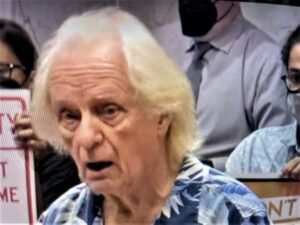BY ED FELIEN

Ed Felien attends a watershed meeting
The Minneapolis City Council Public Works and Infrastructure Committee invited public comments at their June 9 public hearing on their Stormwater Management Program and Annual Report.
I asked them to:
“Please, stop dumping on us.
“You are poisoning us. Chemicals that you put on your lawns in Linden Hills come down Minnehaha Creek and end up in Lake Hiawatha. Come and see your blue-green foam that washes to the shore, but don’t let your dog drink it. It could be lethal.
“And it is not safe for children to swim in the lake.
“My mother taught me to swim at Lake Hiawatha.
“Theodore Wirth designed Lake Hiawatha Park in 1924. He dredged the lake in 1929 to a depth of 33 feet so kids from the proletarian part of town would have someplace to go swimming in the summer. But the city started sanding the streets in winter and washing that sand down storm sewers from Lake Street to 43rd Street, from Chicago Avenue to 27th Avenue into Lake Hiawatha, and now it’s hard to find anywhere on the lake that’s 12 feet deep. It’s so shallow, aquatic life cannot survive the winter. Kids can’t swim in it. The city needs to dredge Lake Hiawatha on a regular basis as simple maintenance and restore it to its original depth of 33 feet.
“The goal of increasing stormwater capacity and the problem of collapsing peat soil infrastructure around Lakes Nokomis and Hiawatha can both be resolved by removing the five-foot dam/weir at 27th Avenue and other obstructions that stop the natural flow of water out of Lake Hiawatha. Lowering the lake level by four and a half to five feet would increase stormwater storage in Lake Hiawatha by 80 million gallons, and it would drain the water table by five feet. Draining five feet of saturated peat soil around Lake Hiawatha will help drain saturated peat soil around Lake Nokomis and Solomon Park because the peat soil connecting those areas is so porous and spongy that (like a wick) it can carry water uphill. Then, when it rains, the water has nowhere to go. The rain from above meets the water from below.
“Please, stop poisoning us with chemicals. Start cleaning out your sand. Get the Park Board to take down the dam/weir. Then bag the garbage with a net coming out of the storm tunnel and have the creek run through a flocculation chamber like Richfield does at Taft Lake to remove the poisonous phosphorus before it gets into the lake.
“Thank you.”
I wrote to Andrew Johnson, chair of the committee:
“I would greatly appreciate an opportunity to sit down with you and the City Engineer to discuss:
1. The feasibility of building a flocculation chamber to remove phosphorus from Minnehaha Creek before it enters Lake Hiawatha.
2. The dredging of sand from Lake Hiawatha that has accumulated as a result of the city sanding the streets in winter.
3. The removal of artificial obstructions to the outflow of Minnehaha Creek from Lake Hiawatha that would reduce the water level of Lake Hiawatha and reduce the water table of the peat soil around Lake Hiawatha, Lake Nokomis and Solomon Park.
4. The city’s responsibility to bag the trash coming out of the storm sewer emptying into Lake Hiawatha.
“I look forward to discussing these problems with you.”
I haven’t heard back.
I’ll keep in touch.
























